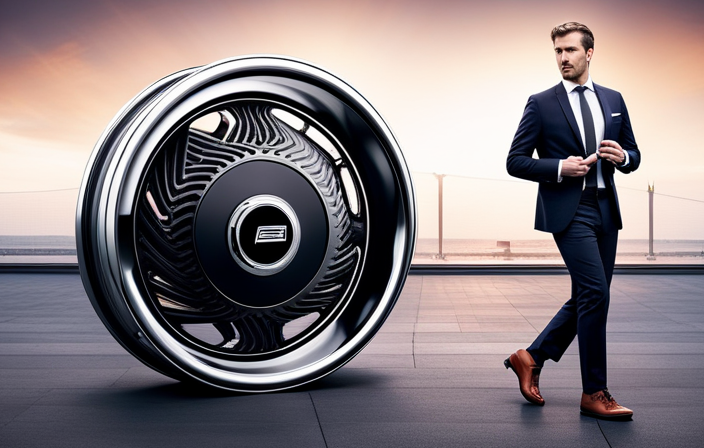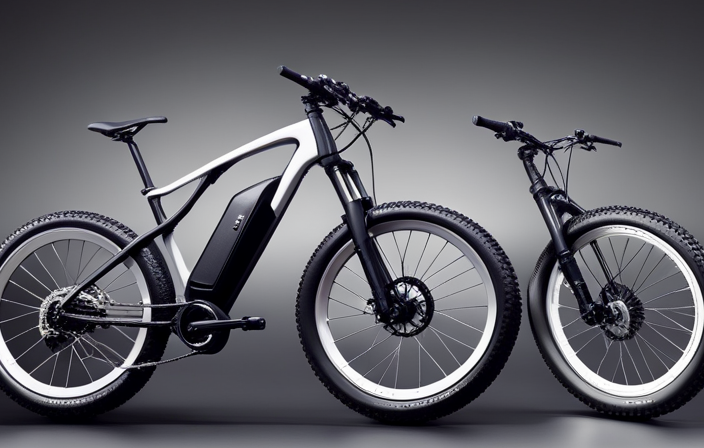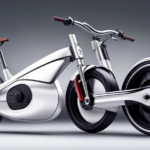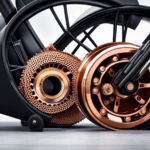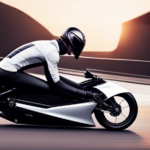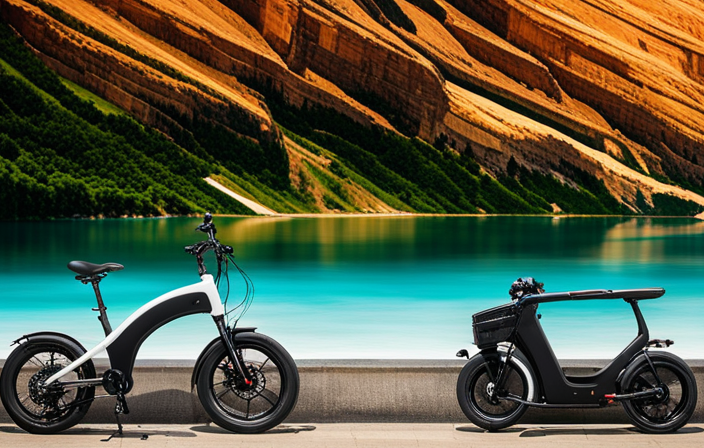Alright, buckle up folks, because we’re about to dive into the fascinating world of electric bike motors.
Ever wondered how these sleek machines zip around effortlessly? Well, wonder no more! In this article, I’ll be breaking down the nitty-gritty of how a motor in an electric bike actually works.
We’ll explore the basic principles of operation, compare brushed and brushless motors, dissect the components, and even delve into regenerative braking.
So, hop on and let’s unravel the mysteries of these electrifying machines!
Key Takeaways
- Electric bike motors use electromagnets for propulsion.
- Brushless motors are more efficient, have longer lifespans, and require less maintenance compared to brushed motors.
- Motor size impacts power, torque, acceleration, and hill-climbing capabilities.
- Finding the right balance between motor size and efficiency is crucial for optimizing performance.
Introduction to Electric Bike Motors
Electric bike motors, also known as hub motors, work by using electromagnets to generate propulsion for your bike. The efficiency of an electric bike motor plays a crucial role in determining its overall performance. Higher efficiency means that more of the electrical energy is being converted into mechanical power, resulting in better performance and longer battery life.
Additionally, the size of the motor can also impact its performance. A larger motor generally provides more power and torque, allowing for faster acceleration and better hill-climbing capabilities. However, it’s important to find the right balance between motor size and efficiency to optimize the performance of your electric bike.
Understanding the basic principles of operation will further enhance your knowledge of how electric bike motors work.
Understanding the Basic Principles of Operation
When it comes to understanding how electric current generates motion in electric bikes, there are a few key points to consider.
First, electric current flows through the motor, creating a magnetic field that interacts with magnets inside the motor. This interaction causes the motor to spin, generating motion.
Second, there are different types of motors used in electric bikes, such as brushless DC motors and hub motors, each with their own advantages and disadvantages.
Lastly, the type of motor used in an electric bike can greatly impact its performance and efficiency, so it’s important to choose the right motor for your specific needs.
How Electric Current Generates Motion
To understand how a motor in an electric bike works, you need to know how electric current generates motion. Here’s a breakdown of the process:
-
Electric current applications: Electric current is the flow of charged particles, typically electrons, through a conductor. In the case of electric bikes, this current is used to power the motor and generate motion.
-
Electromagnetism principles: When electric current flows through a wire, it creates a magnetic field around it. This principle is known as electromagnetism. By manipulating this magnetic field, the motor in an electric bike can produce rotational motion.
-
Stator and rotor: The motor consists of a stationary part called the stator and a rotating part called the rotor. The stator contains coils of wire that produce the magnetic field, while the rotor contains permanent magnets that interact with this field to create motion.
-
Commutation: To keep the rotor spinning continuously, the direction of the magnetic field needs to change periodically. This is achieved through a process called commutation, where the flow of current is switched between different coils in the stator.
Understanding the generation of motion through electric current and electromagnetism is crucial in comprehending how the various types of motors used in electric bikes function.
Types of Motors Used in Electric Bikes
If you’re considering purchasing an electric bike, it’s helpful to know about the different types of motors used. There are two main types of motor controllers: brushed and brushless.
Brushed motors use physical brushes to transfer electrical current to the motor’s rotor, while brushless motors use electronic commutation. Brushed motors are simpler and cheaper, but they have lower efficiency and require more maintenance.
On the other hand, brushless motors are more efficient, have longer lifespans, and require less maintenance. Additionally, electric bikes can have two types of hub motors: front hub motors and rear hub motors.
Front hub motors are easier to install and provide better balance, while rear hub motors offer better traction and are more suitable for off-road riding. Understanding these different types of motors and their advantages can help you make an informed decision when choosing an electric bike.
In the next section, we will explore the differences between brushed motors and brushless motors without using the word ‘step’.
Brushed Motors vs. Brushless Motors
When considering the choice between brushed motors and brushless motors for electric bikes, there are several factors to consider.
Brushed motors have the advantage of being simpler and less expensive, but they also have a shorter lifespan and require more maintenance.
On the other hand, brushless motors are more efficient, have a longer lifespan, and require less maintenance, but they are also more expensive and complex.
Ultimately, the decision between the two types of motors will depend on the specific needs and preferences of the user.
Pros and Cons of Brushed Motors
The pros of using brushed motors in electric bikes include their affordability and simplicity. These motors are relatively inexpensive to produce and maintain, making them a cost-effective choice for electric bike manufacturers. Additionally, brushed motors are straightforward in design and operation, making them easy to understand and repair.
However, there are some downsides to using brushed motors. One major disadvantage is their limited lifespan. The brushes in these motors wear down over time and will eventually need to be replaced. Furthermore, brushed motors are less efficient compared to brushless motors. They have lower power output and are not as energy-efficient, resulting in reduced range and performance for electric bikes.
| Advantages | Disadvantages |
|---|---|
| Affordability | Limited lifespan |
| Simplicity | Lower efficiency |
Despite these drawbacks, brushed motors still have their place in the electric bike industry. However, brushless motors offer several advantages over brushed motors, and we will explore these in the next section.
Pros and Cons of Brushless Motors
You’ll find that brushless motors offer several advantages over their brushed counterparts. One of the main advantages is their higher efficiency. Unlike brushed motors, which have physical brushes that create friction and wear out over time, brushless motors use electronic commutation, eliminating the need for brushes altogether. This results in less energy loss and a longer lifespan for the motor.
Another advantage is their higher power-to-weight ratio. Brushless motors are typically lighter and smaller than brushed motors of the same power output. Additionally, brushless motors are more reliable and require less maintenance due to their simpler design.
However, there are also some disadvantages to consider. Brushless motors are generally more expensive and require more complex electronic control systems. Moreover, they may produce more electrical noise, which can interfere with other electronic devices.
Overall, the advantages of brushless motors outweigh the disadvantages, making them a popular choice in electric bike motors.
Moving on to exploring the components of an electric bike motor…
Exploring the Components of an Electric Bike Motor
Exploring the components of an electric bike motor shows how it functions and operates. The motor efficiency and advancements in motor technology have revolutionized the world of electric bikes, making them more powerful and efficient than ever before.
Here are some key components that contribute to the overall performance of an electric bike motor:
- Brushless motor: This type of motor eliminates the need for brushes, reducing friction and increasing efficiency.
- Stator: The stationary part of the motor that contains the coils, which generate a magnetic field.
- Rotor: The rotating part of the motor that contains magnets, which interact with the magnetic field to produce torque.
- Controller: This electronic device regulates the power delivery to the motor, ensuring smooth operation and optimal performance.
- Sensors: Various sensors, such as speed and torque sensors, provide feedback to the controller, allowing for precise control and efficient power output.
Understanding these components is crucial in comprehending the role of the battery in powering the motor.
The Role of the Battery in Powering the Motor
Understanding how the battery powers the motor is essential in comprehending the overall functionality of an electric bike. The battery serves as the primary source of power, supplying the necessary energy to drive the motor and propel the bike forward. It is important to consider the battery lifespan and the availability of charging infrastructure when selecting an electric bike.
To better understand the role of the battery, let’s take a closer look at its key specifications:
| Specification | Description |
|---|---|
| Capacity | The amount of energy the battery can store, measured in ampere-hours (Ah). |
| Voltage | The electrical potential difference provided by the battery, usually measured in volts (V). |
| Charging Time | The duration required to fully charge the battery, influenced by the charging infrastructure available. |
Power Output and Performance
Now let’s take a closer look at how the power output and performance of the motor are affected by the battery’s specifications and overall functionality.
The power efficiency of the motor depends on the battery’s ability to deliver a consistent voltage and current. The higher the power efficiency, the more energy is converted into useful work, resulting in improved performance.
Additionally, the battery’s capacity affects the motor’s torque and acceleration. A battery with higher capacity can deliver more power, allowing for quicker acceleration and better overall performance.
The battery’s discharge rate also plays a crucial role in power output. A battery with a high discharge rate can provide bursts of power when needed, enhancing acceleration capabilities.
Now, let’s move on to exploring the concept of regenerative braking and its impact on energy efficiency.
Regenerative Braking and Energy Efficiency
To improve the energy efficiency of your electric bike, you can take advantage of regenerative braking, which allows the battery to recharge while you are braking. This innovative technology has various applications and can have a significant impact on both battery life and range. By converting the kinetic energy generated during braking into electrical energy, regenerative braking helps to extend the overall range of your electric bike. Additionally, it reduces the strain on the battery, thus potentially increasing its lifespan. To better understand the benefits of regenerative braking, consider the following table:
| Regenerative Braking Applications | Impact on Battery Life | Impact on Range |
|---|---|---|
| Downhill descents | Positive | Increased |
| Frequent stop-and-go traffic | Positive | Increased |
| Hilly terrains | Positive | Increased |
Maintenance and Troubleshooting Tips
When it comes to maintaining an electric bike, two key areas to focus on are cleaning and lubricating the motor. Regular cleaning helps to remove dirt and debris that can affect the motor’s performance, while lubricating ensures smooth operation and reduces friction.
In this discussion, I will explore the best practices for cleaning and lubricating the motor, as well as common issues that may arise and their solutions.
Cleaning and Lubricating the Motor
Make sure you regularly clean and lubricate your electric bike’s motor to keep it running smoothly. Motor maintenance is crucial for optimal performance and longevity. Here are three important steps to follow:
-
Clean the motor: Use a soft brush or compressed air to remove any dust, dirt, or debris that may have accumulated on the motor. Pay special attention to the cooling fins and vents to ensure proper airflow.
-
Use the right lubricant: Choose a high-quality lubricant specifically designed for electric bike motors. Apply a small amount to the bearings and moving parts, such as the gears and shafts. Avoid over-lubricating, as it can attract dirt and cause clogging.
-
Check for wear and tear: Regularly inspect the motor for any signs of damage, such as loose wires or worn-out components. If you notice any issues, consult a professional technician for repairs or replacements.
Common Issues and Solutions
One common issue with electric bike motors is overheating, which can be solved by ensuring proper airflow and regularly cleaning the cooling fins and vents. Overheating can occur when the motor is under heavy load or when the weather is hot. To troubleshoot this issue, it is important to check if the motor is getting adequate airflow. Make sure that there are no obstructions blocking the cooling fins or vents. Additionally, regular cleaning of the cooling fins and vents helps to remove any dirt or debris that may hinder the cooling process. By following these troubleshooting solutions, you can prevent overheating and ensure optimal performance of your electric bike motor.
| Common Issues | Troubleshooting Solutions |
|---|---|
| Overheating | Ensure proper airflow |
| Regularly clean cooling fins and vents | |
When it comes to electric bike motors, safety is of paramount importance. Transitioning into the next section about safety considerations, it is crucial to address potential hazards and precautions to take while using an electric bike.
Safety Considerations
When it comes to safety considerations, there are three key points that need to be discussed: proper helmet and protective gear, traffic rules, and awareness.
Wearing a helmet is crucial to protect the head from potential injuries in case of accidents.
Additionally, understanding and following traffic rules and being aware of one’s surroundings can greatly reduce the risk of accidents on the road.
Proper Helmet and Protective Gear
Wearing a helmet and protective gear is essential when riding an electric bike. As a rider, I understand the importance of helmet safety and the significance of wearing proper protective gear. Here are some key reasons why helmet safety and protective gear are crucial:
- Helmets provide protection against head injuries, reducing the risk of severe trauma in case of accidents.
- Protective gear like knee and elbow pads, as well as gloves, safeguard us from abrasions and fractures.
- High-visibility clothing enhances our visibility to other road users, reducing the chances of collisions.
- Wearing protective gear instills confidence and promotes a responsible attitude towards safety.
Ensuring that we are properly equipped with helmets and protective gear significantly reduces the risk of injuries while riding an electric bike.
Moving forward, understanding and adhering to traffic rules and awareness are essential aspects of safe electric bike riding.
Traffic Rules and Awareness
Following traffic rules and staying aware of our surroundings is crucial for safe riding on an electric bike. With the increasing traffic congestion in our cities, it is important to adhere to traffic regulations to ensure road safety.
As an electric bike rider, I make sure to always obey traffic signals, yield to pedestrians, and maintain a safe distance from other vehicles. Being aware of my surroundings allows me to anticipate potential hazards and react accordingly.
Additionally, I prioritize wearing high-visibility clothing and using proper lighting to make myself more visible to other road users. By following these guidelines, I can contribute to reducing accidents and promoting a safer environment for everyone on the road.
Looking ahead, let’s explore the future developments and innovations in electric bike motors.
Future Developments and Innovations in Electric Bike Motors
There’s no doubt that future developments and innovations in electric bike motors will continue to revolutionize the cycling industry. The advancements in electric bike motors are driving the industry towards a more efficient and sustainable future.
Here are three key areas where we can expect to see significant improvements in the coming years:
-
Motor efficiency: As technology advances, electric bike motors will become increasingly efficient, allowing for longer battery life and greater range. This will enable cyclists to travel longer distances without worrying about running out of power.
-
Integration of smart features: Future electric bike motors will be equipped with intelligent features such as automatic gear shifting, regenerative braking, and smartphone connectivity. These features will enhance the overall riding experience and make electric bikes more user-friendly.
-
Lightweight and compact designs: Manufacturers are constantly working towards developing lighter and more compact electric bike motors. This will not only make the bikes easier to handle and maneuver but also improve their overall performance and efficiency.
With these future developments and innovations, electric bike motors will continue to play a significant role in promoting sustainable transportation and revolutionizing the way we commute.
Frequently Asked Questions
What are the different types of electric bike motors available in the market?
There are two main types of electric bike motors available in the market: brushless and brushed motors. Additionally, there are direct drive and geared motors. Each type has its own advantages and considerations for efficiency, power output, and maintenance requirements.
How does the motor controller in an electric bike work?
The motor controller in an electric bike acts as the brain, efficiently regulating the power flow from the battery to the motor. It plays a crucial role in optimizing battery life, ensuring every ounce of energy is used effectively.
Can an electric bike motor be upgraded or replaced with a more powerful one?
Yes, the motor in an electric bike can be upgraded or replaced with a more powerful one. This allows for increased speed and performance. Upgrading or replacing the motor requires technical knowledge and expertise to ensure compatibility and proper installation.
What is the average lifespan of an electric bike motor?
The average lifespan of an electric bike motor is around 10,000 to 20,000 miles. Proper electric bike motor maintenance, such as regular cleaning and lubrication, can help extend its lifespan. Signs of a failing motor include decreased power and strange noises.
Are there any specific regulations or legal requirements for using electric bike motors in different countries?
Electric bike motor regulations and legal requirements vary across countries. It is important to research and adhere to the specific rules in your location regarding speed limits, power output, age restrictions, and any required licenses or registrations.
Conclusion
In conclusion, understanding how a motor in an electric bike works is crucial for any enthusiast or rider. The intricate interplay of components, from the battery to the regenerative braking system, ensures an efficient and smooth ride.
Just like a well-oiled machine, these motors power our journeys, propelling us forward with a silent hum. As technology continues to advance, we can expect exciting developments and innovations in electric bike motors, making our rides even more exhilarating.
So, hop on your electric bike and experience the future of cycling!
